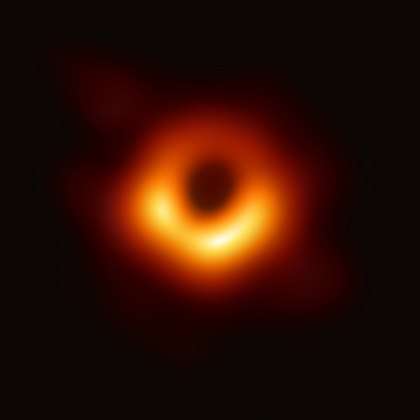ER=EPR
ER=EPR is a conjecture in physics stating that two entangled particles (a so-called Einstein-Podolsky-Rosen or EPR pair) are connected by a wormhole (or Einstein–Rosen bridge)[1][2] and may be a basis for unifying general relativity and quantum mechanics into a theory of everything.[1]
Overview
The conjecture was proposed by Leonard Susskind and Juan Maldacena in 2013.[3] They proposed that a non-traversable wormhole (Einstein–Rosen bridge or ER bridge) is equivalent to a pair of maximally entangled black holes. EPR refers to quantum entanglement (EPR paradox).
The symbol is derived from the first letters of the surnames of authors who wrote the first paper on wormholes (Albert Einstein and Nathan Rosen)[4] and the first paper on entanglement (Einstein, Boris Podolsky and Rosen).[5] The two papers were published in 1935, but the authors did not claim any connection between the concepts.[2]
Preliminary evidence, though indirect, for ER=EPR is that a certain entangled pair has been realized as an ER bridge using AdS/CFT correspondence.[6]
Conjectured resolution
This is a conjectured resolution to the AMPS firewall paradox. Whether or not there is a firewall depends upon what is thrown into the other distant black hole. However, as the firewall lies inside the event horizon, no external superluminal signalling would be possible.
This conjecture is an extrapolation of the observation by Mark Van Raamsdonk[7] that a maximally extended AdS-Schwarzschild black hole, which is a non-traversable wormhole, is dual to a pair of maximally entangled thermal conformal field theories via the AdS/CFT correspondence.
They backed up their conjecture by showing that the pair production of charged black holes in a background magnetic field leads to entangled black holes, but also, after Wick rotation, to a wormhole.
Susskind and Maldacena envisioned gathering up all the Hawking particles and smushing them together until they collapse into a black hole. That black hole would be entangled, and thus connected via wormhole, with the original black hole. That trick transformed a confusing mess of Hawking particles—paradoxically entangled with both a black hole and each other—into two black holes connected by a wormhole. Entanglement overload is averted, and the firewall problem goes away.
— Andrew Grant, "Entanglement: Gravity's long-distance connection", Science News [8]
This conjecture sits uncomfortably with the linearity of quantum mechanics. An entangled state is a linear superposition of separable states. Presumably, separable states are not connected by any wormholes, but yet a superposition of such states is connected by a wormhole.[9]
The authors pushed this conjecture even further by claiming any entangled pair of particles—even particles not ordinarily considered to be black holes, and pairs of particles with different masses or spin, or with charges which aren't opposite—are connected by Planck scale wormholes.
The conjecture leads to a grander conjecture that the geometry of space, time and gravity is determined by entanglement.[2][10][11]
References
- Staff (2016). "This New Equation Could Unite The Two Biggest Theories in Physics". futurism.com. Retrieved May 19, 2017.
- Cowen, Ron (16 November 2015). "The quantum source of space-time". Nature. 527 (7578).
- Maldacena, Juan; Susskind, Leonard (2013). "Cool horizons for entangled black holes". Fortsch. Phys. 61 (9): 781–811. arXiv:1306.0533. Bibcode:2013ForPh..61..781M. doi:10.1002/prop.201300020.
- Einstein, A.; Rosen, N. (1 July 1935). "The Particle Problem in the General Theory of Relativity". Physical Review. 48 (1): 73–77. Bibcode:1935PhRv...48...73E. doi:10.1103/PhysRev.48.73.
- Einstein, A.; Podolsky, B.; Rosen, N. (15 May 1935). "Can Quantum-Mechanical Description of Physical Reality Be Considered Complete?". Physical Review (Submitted manuscript). 47 (10): 777–780. Bibcode:1935PhRv...47..777E. doi:10.1103/PhysRev.47.777.
- H. Gharibyan; R. F. Penna; 2014; Physical Rev. D 89 , 06601
- van Raamsdonk, Mark (2010). "Building up spacetime with quantum entanglement". Gen. Rel. Grav. 42 (14): 2323–2329. arXiv:1005.3035. Bibcode:2010IJMPD..19.2429V. CiteSeerX 10.1.1.694.9818. doi:10.1142/S0218271810018529.
- Grant, Andrew (7 October 2015). "Entanglement: Gravity's long-distance connection". ScienceNews. Retrieved 6 May 2018.
- "Entangled universe: Could wormholes hold the cosmos together?". Medium. 2016-03-13. Retrieved 2017-05-20.
- Susskind, Leonard (2016). "Copenhagen vs Everett, Teleportation, and ER=EPR". Fortschritte der Physik. 64 (6–7): 551–564. arXiv:1604.02589. Bibcode:2016ForPh..64..551S. doi:10.1002/prop.201600036.
If we believe in the ambitious form of ER=EPR, this implies the presence of an Einstein-Rosen bridge connecting the superposed wave packets for a single particle.
- Sean M. Carroll (July 18, 2016). "Space Emerging from Quantum Mechanics".
A related notion is the ER=EPR conjecture of Maldacena and Susskind, relating entanglement to wormholes. In some sense, we’re making this proposal a bit more specific, by giving a formula for distance as a function of entanglement.
External links
- Susskind, Leonard. "ER = EPR" or "What's Behind the Horizons of Black Holes?". Stanford Institute for Theoretical Physics. November. 4, 2014.
